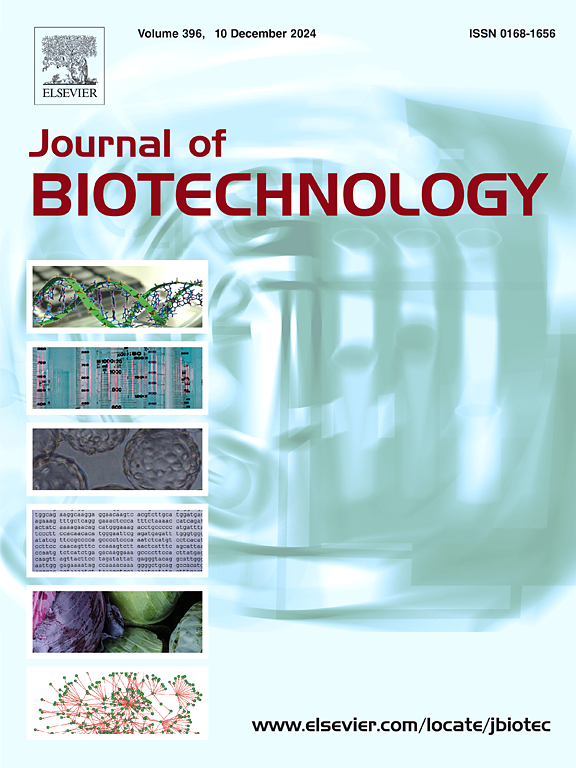Biostimulant-driven growth enhancement and stress resistance in tomato: The combined impact of alginate, chitosan, and salicylic acid
IF 3.9
2区 生物学
Q2 BIOTECHNOLOGY & APPLIED MICROBIOLOGY
引用次数: 0
Abstract
Mechanical wounding, a significant cause of yield loss in agricultural crops, has prompted recent efforts to identify effective solutions, such as applying biostimulants that not only improve plant growth but also enhance resistance to mechanical damage. This study evaluates the combined effects of alginate (Al-1, 0.75 mg mL−1), salicylic acid (SA, 100 µM), and chitosan (Ch, 0.75 mg mL−1) on tomato plant growth, biochemical responses, and recovery from mechanical wounding. The results indicate that Al-1 accumulates at the plant cell wall, transitioning from a liquid to a film-like state. During this process, Al-1 also loses over 50 % of its sodium ions and fails to acquire nitrogen ions from Ch. However, the combined application of Al-1, SA, and Ch significantly promotes plant growth and enhances mechanical stress resistance by increasing chlorophyll, sugar, protein, and carotenoid levels, as well as improving xylem development compared to other treatments. Furthermore, the Al-1 +Ch+SA combination elevates H2O2 levels and APX activity in adjacent leaves 60 min after wounding; although this response is delayed compared to a individual treatments. These findings suggest that this combination of biostimulants enhances plant resilience to mechanical injury, offering potential for improving crop yield and quality in stress-prone agricultural systems
生物刺激剂促进番茄生长和抗逆性:海藻酸盐、壳聚糖和水杨酸的联合作用
机械损伤是农作物产量损失的一个重要原因,近年来人们努力寻找有效的解决方案,例如使用生物刺激剂,不仅可以促进植物生长,还可以增强对机械损伤的抵抗力。本研究评估了海藻酸盐(Al-1, 0.75 mg mL−1)、水杨酸(SA, 100 µM)和壳聚糖(Ch, 0.75 mg mL−1)对番茄植株生长、生化反应和机械损伤恢复的联合影响。结果表明,Al-1在植物细胞壁积累,从液体状态过渡到膜状状态。在这一过程中,Al-1也损失了超过50% %的钠离子,并且无法从Ch中获取氮离子。然而,与其他处理相比,Al-1、SA和Ch联合施用可以通过提高叶绿素、糖、蛋白质和类胡萝卜素水平,以及改善木质部发育,显著促进植物生长和增强机械抗逆性。此外,Al-1 +Ch+SA组合在伤后60 min可提高邻近叶片H2O2水平和APX活性;尽管与单独治疗相比,这种反应是延迟的。这些发现表明,这种生物刺激剂的组合增强了植物对机械损伤的恢复能力,为在易受压力的农业系统中提高作物产量和质量提供了潜力
本文章由计算机程序翻译,如有差异,请以英文原文为准。
求助全文
约1分钟内获得全文
求助全文
来源期刊

Journal of biotechnology
工程技术-生物工程与应用微生物
CiteScore
8.90
自引率
2.40%
发文量
190
审稿时长
45 days
期刊介绍:
The Journal of Biotechnology has an open access mirror journal, the Journal of Biotechnology: X, sharing the same aims and scope, editorial team, submission system and rigorous peer review.
The Journal provides a medium for the rapid publication of both full-length articles and short communications on novel and innovative aspects of biotechnology. The Journal will accept papers ranging from genetic or molecular biological positions to those covering biochemical, chemical or bioprocess engineering aspects as well as computer application of new software concepts, provided that in each case the material is directly relevant to biotechnological systems. Papers presenting information of a multidisciplinary nature that would not be suitable for publication in a journal devoted to a single discipline, are particularly welcome.
 求助内容:
求助内容: 应助结果提醒方式:
应助结果提醒方式:


